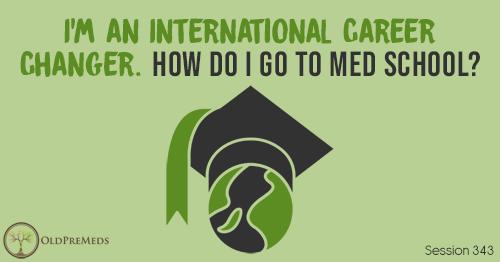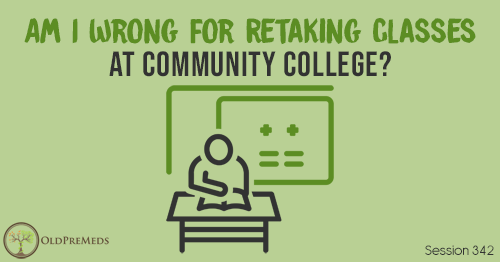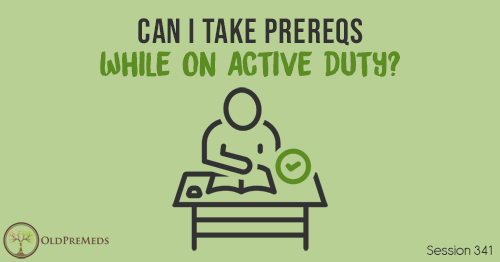Apple Podcasts | Google Podcasts
Session 59
This week’s question is an interesting one about choosing which schools to apply to. The question is, should the residency match rate of a medical school impact your decision about whether or not to apply there?
Listen to this podcast episode with the player above, or keep reading for the highlights and takeaway points.
OldPreMeds Question of the Week:
“I was looking into residency match rates of DO versus MD programs using the school websites and comparing them to data from NRMP. I noticed that the 2016 data for DO match rate was 80.3% versus 93.8% for MD.
When I look at the data from DO schools like Western and Touro, I find reports of 90% to 100% match rates. Is the difference because of the specific schools, whereas the 80.3% averages together all DO programs? Should one look at the individual school match rate instead of the overall match rate when choosing a program? If anyone has information about the discrepancies, please let me know.”
(2:00) Questioning the data
I dug into this a little bit to figure out where this person was getting their data. I pulled up the information from the American Osteopathic Association Intern and Residency Registration Program match data; this is the matching system for DO students. I also looked at the National Resident Matching Program (NRMP) that matches for MD residencies.
So just to backtrack and give you a little information: DO and MD. A DO is a doctor of osteopathic medicine, and an MD is a medical doctor. DO and MD are just two different types of medical school. Both lead to being a physician in the end; there’s really no difference and actually, their residency programs are soon merging.
DO and MD are just two different types of medical school. Both lead to being a physician in the end. There's really no difference.Click To TweetNot a lot of information has come out on how the residency merger is happening, but I believe the year is 2020 when that happens. Therefore, much of this information, by the time you start medical school and as you’re listening to this, perhaps it won’t matter because much of it will have changed. However, I still wanted to reply to this question because I thought it was a good one.
[Related post: MD vs DO: What Are the Differences (and the Similarities)?]
(3:20) Residency Match Rates for DO Schools
This student is claiming the 2016 data for DO match rate was 80.3%. However, when I bring up the 2016 match data, I see an unmatched rate of 13%, which is a match rate of 87% for DOs. So I’m not sure where this student was coming up with 80.3%.
If you just look up DO match rates for 2016, the website comes up and it’s the match data for the DO applications and has a list of every school.
Comparing Residency Match Rates for DO Medical Schools
The highest non-match rate for any school is 28.6%, so that’s a match rate of 71.4%, which isn’t very good at all. That school is Touro University in Nevada (TUNCOM). There are several different Touro schools, and that is the worst one by far. The next closest school on the list isn’t far behind, at 26.9% non-match, and that one is William Carey University College of Osteopathic Medicine in Mississippi.
(5:15) Matching vs. Unmatched
The way that the AOA lists this statistic is that they include percentage matched, percentage non-matched, and percentage of non-participants. When you look at percentage matched, it’s only 40.9% and you might think, “Wow that’s crazy, how come nobody’s matching?'”But you need to combine that figure with the “non-participants.”
As a DO student, you can match through the MD matching program, and then you’re counted as a non-participant. When you combine the percentage matched at 40.9% with the percentage not participating at 46.1%, the result is 87%. This leaves the leftover of non-matched students at 13%. So 87% of DO students are matching.
(6:35) Is every residency spot getting filled?
Not every prelim spot in residency is getting filled. Now here’s something to think about when it comes to residency matching. When I looked at the NRMP match data, they have the total match of 96.3% of all US spots filled. So not every residency spot is getting filled, which is not good. The prelim spots are especially not getting filled.
Despite 13% of DO students going unmatched, not every residency spot is getting filled.Click To TweetA prelim spot is only for your PGY1 year (PGY1 = Post-graduate year 1). It’s basically saying, “Hey come to our prelim spot, and try out for our residency.” It is basically for if you didn’t match anywhere else, then take a prelim spot, and you can hopefully come into our program after you do well in your prelim year. If you look at surgery prelim spots according to NRMP, it only filled 64.4%. So there were a lot of spots still available.
(8:00) Know yourself, and know your competition
What does this all mean? It means that a lot of the people who aren’t matching are probably trying to match into a very competitive program that they aren’t qualified to match into. It’s very similar to trying to get accepted to Harvard, Yale, and Wash U medical schools when you have a 3.0 GPA and a 500 on the MCAT. You’re dreaming a little bit too big.
It also could be that the specific year that you’re applying for something is a very competitive year, and a lot of people are trying to match into the programs you want, and you just didn’t make the cut.
Unfilled Residency Spots and SOAP
Typically, if you don’t match into any of the residency programs that you listed on your match list, you will have an opportunity to go through the Supplemental Offer and Acceptance Program (SOAP, formerly called Scramble). You get notified that you did not match, and you then enter this SOAP program. You find residencies that didn’t fill, and you can get one of those remaining spots.
A lot of the unfilled spots available through SOAP are going to be PGY1-only spots. Some of them may be internal medicine spots when you wanted to do something else besides internal medicine. However, there are these unfilled spots available, and if you want to match into one of those programs, you can.
So this is a whole separate system outside of the normal match program. It allows students who didn’t match to get into a program to still continue their post-graduate training, which is necessary if you want to be a doctor here in the US.
SOAP is a whole separate system outside of the normal residency match program. It allows students who didn't match to still get into a program and continue their post-graduate training.Click To Tweet(9:38) Asking questions about residency match rates
My personal belief? You shouldn’t look at residency match rates for choosing which schools to apply to, with one exception. Look at those huge outliers like Touro Nevada, like William Carey University, and ask yourself:
- Why is their match rate so low?
- Are they a brand new school and they’re just getting ramped up?
- Perhaps their first round of students they let in weren’t the best?
- Are they just getting their curriculum under control?
- Are they under some sort of probation because their curriculum isn’t training students well enough?
Then call the school and say, “Hey, I noticed your residency match rates are pretty terrible,” and find out from them what they have to say. If it’s a school that you’re interested in going to because the location is perfect for you, consider it.
[Related episode: Should I Meet with Admissions Committees Before I Apply?]
(10:45) Past performance does not predict future performance.
It’s like the stock market: It doesn’t matter what the stock market did yesterday. That doesn’t determine what it will do tomorrow. Sometimes the past is a good predictor, a rule of thumb to think about, but things change, people change, professors change.
You—the person who is actually learning and studying and figuring this all out—are one of the biggest variables to all of this, as well. If you are motivated, if you are driven, if you are determined to get whatever residency spot you want, then you will probably do well.
You cannot rely on your medical school to help you match somewhere. The school is there to help support you, but you need the drive and motivation to do it yourself. That’s going to be true wherever you go to school.
(11:32) The bottom line when it comes to residency match rates
When it comes to residency match rates and picking your medical school, I would say to look at those huge outliers, but outside of those, I wouldn’t consider it. Location, curriculum, and many other factors are going to be far more important for allowing you to do your best work and get your best possible board scores, which are really what will allow you to match into the residency you want.
Links and Other Resources
- Check out my Premed Playbook series of books (available on Amazon), with installments on the personal statement, the medical school interview, and the MCAT.
- Related post: Should We Even Have a DO Degree? The DO vs MD Argument.
- Related episode: The Role of Residency Training for Physicians.
- Need MCAT Prep? Save on tutoring, classes, and full-length practice tests by using promo code “MSHQ” at Blueprint MCAT (formerly Next Step Test Prep)!












